|
|
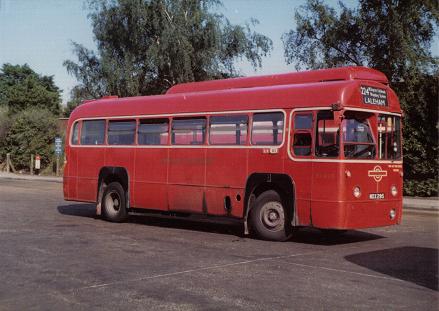 Red RF routes Red RF routes
Route 224
Page last updated 27 December 2018
One of the Uxbridge routes serving West Drayton, the 224
featured RFs twice in its history, for two different reasons -
first the low bridges around West Drayton, then later when
converted to OMO (for the third time - read on).
RF407 seen in OMO
configuration, sitting in Uxbridge Bus Station (before the garage
was built over this area) awaiting departure for Laleham.
Photo Peter Gomm
collection
Dates of RF operation
26 Nov 58 (weekends), 10 Jun 59 (daily) to 7 May 63
and
16 Jan 71 to 11 Dec 76
(total 10 years 4 months, of which 4
years 5 months crew operation).
Destinations (see maps below)
UXBRIDGE STATION and LALEHAM Broadway (daily 26
Nov 58 to 7 May 63, Mon-Fri peaks and Sat shop hours 16 Jan 71 to
14 May 76)
UXBRIDGE STATION and STAINES Moor Lane (Mon-Fri
off peak and Sat outside shopping hours 16 Jan 71 to 14 May 76)
UXBRIDGE STATION and COLNBROOK Coleridge Crescent
(Mon-Sat 15 May to 11 Dec 76)
UXBRIDGE STATION and POYLE GAF Factory
(journeys Mon-Fri peaks 15 May to 11 Dec 76)
RF Garages
UX Uxbridge
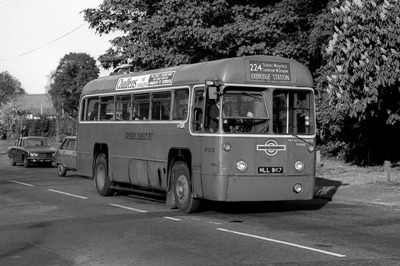
OMO RF350 in the 1970s.
Photo © Eamonn Kentell
Reason for single-deck operation
The low bridges at Yiewsley and West Drayton Station
restricted routes through Cowley to single-deck. In
1961, the road at West Drayton was lowered (allowing the
double-deck 223 to be extended southward,
replacing the 222. Soon afterwards,
the layout at Yiewsley was changed (we don't know how, but the
railway didn't close until 1964). The 224 was not
double-decked until 1963, although 224A and 224B and 224C were converted a year
earlier. 224 and 224 B reverted to single-deck in
1971 for OMO conversion.
Route history
Dating from July 1929 as the General's route
506, Uxbridge to Staines, the route was worked by Uxbridge (UX)
garage using crew-operated K and S-type
single-deckers. In order to improve the economics of its
peripheral routes, the General introduced one-man operation with
new DA-class Dennis Darts in 1930. The first converted
the 505 and 506 on 26 Jun 30. In
March 1932, the 506 (since October 1930 running weekdays
only) was extended from Staines to Stanwell.
On renumbering as 224 on 3 Oct 34,
an additional working from Hounslow garage (AV) was added, also an
OMO Dart, running Saturdays and Sundays only between Staines and
Stanwell - the beginning of the unsettled Staines to
Stanwell Sunday workings that became RF operated as
the 203 in 1965. These
comprised the only Sunday workings on the 224. The Darts
continued until the outbreak of war, when they were replaced by
diesel-engined CRs (UX) and a Cub (AV).
The war saw a number of route withdrawals at
less busy times. On the 224, this comprised withdrawal south
of Harmondsworth in the evening, for various periods. This
left unchanged the busy section from Uxbridge to the 'Peggy
Bedford' on the Bath Road, by what is now Heathrow Airport North
but was then Fairey's Great Western Aerodrome and no doubt involved
in war work. In March 1942, the southern section was
transferred to the 223, including the
weekend Hounslow Cub working, and the remaining Uxbridge to
Harmondsworth section was upgraded to crew-operated Ts (mainly 1T1s
with some ex-Tilling 3T3s). These were amongst the first Ts
converted to perimeter seating, permitting up to 50 passengers
including 25 standing.
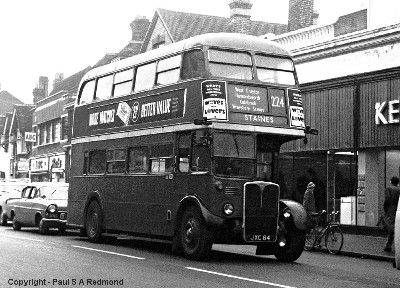
Uxbridge's RT701 runs to
Staines during the sixties.
Photo © Paul
Redmond
On 28 Oct 42, things start getting complicated. The
223 Stanwell workings were transferred back to the 224,
which retained crew-operation on the Uxbridge to Harmondsworth
section. Harmondsworth to Stanwell (Mon-Fri between peaks)
and through workings at other times were covered by OMO Cubs (the
CRs by now having gone into store). This was thus the
second OMO conversion. Three weeks later, the AV weekend
Staines to Stanwell workings were taken over by UX.
On 3 Oct 45, between peaks through journeys were reintroduced
and the whole route converted to crew-operated Ts, but the Stanwell
to Staines weekend journeys were returned to AV-operation, also
with a crew T. In May 1946, Sunday operation was introduced
on the northern section from Uxbridge to Harmondsworth, meaning the
route ran in two separate sections on that day. One wonders
why the Hounslow-based journeys hadn't been given a separate route
number.
On 4 May 47, Sunday working was reintroduced over the whole
route for the first time since 1930 and the separate Stanwell to
Staines service was withdrawn on that day - but still operated on
Saturday for a further six months, even though the route was
also covered by through buses. On 24 Mar 48, the
Stanwell to Staines section was withdrawn entirely and replaced by
new ST-operated route 162 running between those points only.
In place of Stanwell, the 224 was rerouted to Laleham.
The Uxbridge to Laleham route then continued until the end of the
RF era, except that the route was temporarily withdrawn between
Uxbridge and West Drayton while the railway bridge was rebuilt,
November 1959 to September 1960.
After the war, the variety of Ts increased with a
number of repainted 11T11 former Green Line coaches from 1946,
followed in December 1949 by eight green 9T9s transferred from
the Country Area, following which most of the 11T11s moved to
Loughton. The 9T9s were in turn replaced by red 10T10s
in October 1951, made available indirectly by the introduction of
the Green Line RFs. Uxbridge was the first recipient in 1946
of post-war 14T12s, nominally for the 223 but also
occasionally on the 224. By 1953, all the prewar Ts had
been replaced by 14T12s. These lasted
until 26 Nov 58 and with Southall's 211 allocation were the last of the class in
service. They were replaced at weekends by a mix of TDs and
RFs (spare from the 222, initially on
Saturday and Sunday, but on Saturday only from 13 May 59) and
by TDs during the week, until the TDs were were in turn
replaced by further RFs from 10 Jun 59.
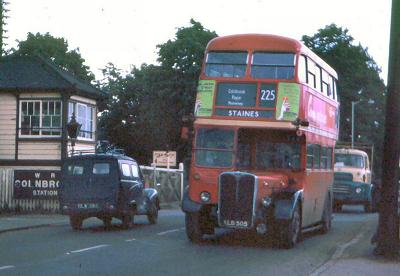 The 225 was a new route introduced
between West Drayton and Staines Moor Lane in 1965, to
serve Poyle Trading Estate upon closure of the West Drayton to
Staines West railway line. It ran Mon-Fri peak hours and
followed the 224 except that it used Poyle Road to cut off the
Horton loop. RT1256 is seen crossing the Colnbrook level
crossing in 1965. The route was replaced in 1971 by journeys
on the 224. The 225 was a new route introduced
between West Drayton and Staines Moor Lane in 1965, to
serve Poyle Trading Estate upon closure of the West Drayton to
Staines West railway line. It ran Mon-Fri peak hours and
followed the 224 except that it used Poyle Road to cut off the
Horton loop. RT1256 is seen crossing the Colnbrook level
crossing in 1965. The route was replaced in 1971 by journeys
on the 224.
Photo © Bob Turner, Ian Armstrong
collection
Meanwhile, in 1955 and 1957 respectively, two variants in the
form of 224A and 224B were introduced, both also
initially T operated. From November 1959 to September 1960,
the first barrier to double-deck operation, the road under the
bridge at West Drayton, was rebuilt. While the road was
closed, RFs on the 222 provided the service through Cowley, with
the 224 group operating the southern sections only. In
March 1961, the bridge now open, the 222 was discontinued and
the 223 extended from West Drayton to Hounslow in replacement
and a third 224 offshoot, 224C, appeared to provide a service
along Cowley Road to Heathrow in rush hours. This road,
restricted by a further low bridge at Yiewsley, was now served
only by the 224 group.
The low bridge at Yiewsley was dealt with shortly
after, allowing the 224A/B/C to
be converted to RT on 9 May 62, although the 224 itself held on to
its RFs for another year (possibly because there was thought
of OMO conversion, if union agreement could be reached?)
until 7 May 63. From that date, RTs took over and for
six weeks only, one Monday to Friday pm journey was extended from
Uxbridge to Ruislip Station over the 204.
To a large extent, the 224 followed a pair of the Great
Western's branch lines, the
West Drayton to Uxbridge already mentioned and the
West
Drayton to Staines West. The former served Uxbridge Vine
Street, Cowley and West Drayton, the latter West Drayton,
Colnbrook, Poyle and Staines West. The main deviation from
the railway was at Poyle, where the 224 ran instead down
Horton Road to the west. The level crossing at
Colnbrook appears to have been the
only one crossed by a red RF route. The forecourt
of Staines West station provided the Staines terminus of most bus
routes terminating in Staines, including the 203, 216, 218; the well-known station building (see photo
at foot of page) was a Georgian mill owner's house altered to serve
as a station. The West Drayton to Uxbridge line closed to
passengers in 1962, the West Drayton to Staines West in 1965.
RT-operated route 225 was provided Mon-Fri peak hours as rail
replacement to serve Poyle Trading Estate.
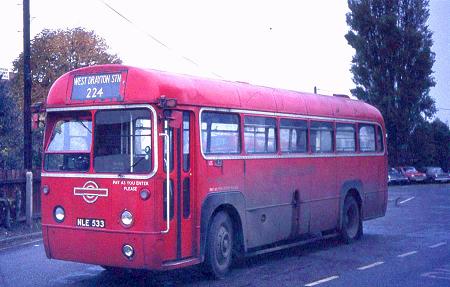
RF533 looks very uncared for
on 30 Oct 76, with just 6 weeks left to run before its final move
to Kingston. It stands at West Drayton, having worked in on a
short working. This RF was one of the green batch repainted
red whilst at Sidcup in 1956 and worked at Uxbridge before an early
OMO conversion in 1959 and again in the early 1960s.
Photo © John Parkin
There followed a period of stability for the rest of the
sixties, only slightly disturbed by the shortening of the 224 on
Sundays from Laleham to Harmondsworth in October 1969.
The next substantial change came on 16 Jan 71, when the route
was converted from RT to OMO RF. The 224 was withdrawn on
Sundays and its journeys beyond Staines to Laleham were now
restricted to Mon-Fri peaks and Saturday shopping hours. Some
Mon-Fri peak journeys were diverted to run via Poyle, rather than
Horton, replacing the 225 which was withdrawn.
From December 1974, Monday to Friday peak hour
journeys via Poyle were re-routed at the Industrial Estate
along Blackthorne Road to serve the GAF factory. In May 1976,
the southern section from Colnbrook to Staines, which (perhaps
surprisingly) are in Buckinghamshire, was withdrawn due to a lack
of support from Bucks Council. The peak hour journeys to the
GAF factory were retained.
The end came for the Uxbridge RFs in December 1976, when
the 224 converted to SMS and the 223 and 224B went
to DMS. Saturday operation ceased in September 1977 and
the route was withdrawn entirely on 21 Apr 78.
|
RF route in detail, with timing points
UXBRIDGE STATION, Belmont Road, High Street Uxbridge, Vine
Street (return via Windsor Street), Cowley Road, High Street
Cowley, Cowley Station
Road, High Street Cowley, High Road Cowley, High
Street Yiewsley, Station Approach, West Drayton Station, Station
Approach, Station Road, Harmondsworth Road, Holloway Lane,
Harmondsworth High
Street, Hatch Lane, Hatch Lane Bath Road, Bath Road,
Bath Road Colnbrook, Park Street, Bridge Street, High Street
Colnbrook, Colnbrook Horton
Road, Horton Road, Horton
Crown, Stanwell Road, Coppermill Road, Wraysbury Station, Station Road, High
Street Wraysbury, Staines Road, Wraysbury Road, Church Street,
Staines Clarence
Street, High Street Staines, London Road, Kingston
Road, Worple Road Withygate
Avenue, Worple Road, Staines Road, Broadway, LALEHAM
Broadway (daily 26 Nov 58 to 7 May 63).
UXBRIDGE STATION, Belmont Road, High Street Uxbridge,
Harefield Road, Oxford Road, Trumpers Way (northbound), Cross
Street (southbound) (rerouted from 1963 routing on 19 Aug 73),
Cowley Road, High Street Cowley, Cowley Station Road, High Street
Cowley, High Road Cowley, High Street Yiewsley, Station
Approach, West Drayton
Station, Station Approach, Station Road, Harmondsworth
Road, Holloway Lane, Harmondsworth
High Street, Hatch Lane, Hatch Lane Bath Road, Bath Road,
Bath Road Colnbrook, Park Street, Bridge Street, High Street
Colnbrook, Colnbrook Old
George, Horton Road, Horton Crown, Stanwell Road,
Coppermill Road, Wraysbury
Station, Station Road, High Street Wraysbury, Staines Road,
Wraysbury Road, Bridge Street, Clarence Street, STAINES High
Street (return via South Street, Thames Street, rerouted from
1963 route on 6 Jan 74), extended Mon-Fri peaks and Sat shop hours
via High Street Staines, London Road, Kingston Road, Worple
Road, Worple Road Staines
Road, Staines Road (formerly Laleham Road), Broadway
(formerly Ashford Road), LALEHAM Church (Mon-Sat 16
Jan 71 to 14 May 76).
Mon-Fri peak journeys diverted from Bath Road, Colnbrook via
Poyle Trading Estate as follows: (16 Jan 71 to 1 Dec 74) Poyle
Road, Poyle Golden
Cross, Stanwell Road to Coppermill Road; (2 Dec 74 to
14 May 76) Poyle Road, Blackthorne Road, Poyle Trading Estate GAF Works,
Blackthorne Road, Poyle Road, Poyle
Golden Cross, Stanwell Road to Coppermill Road.
UXBRIDGE STATION, Belmont Road, High Street Uxbridge,
Harefield Road, Oxford Road, Trumpers Way (northbound), Cross
Street (southbound), Cowley Road, High Street
Cowley, Cowley Station
Road, High Street Cowley, High Road Cowley, High
Street Yiewsley, Station Approach, West Drayton Station, Station
Approach, Station Road, Harmondsworth Road, Holloway Lane,
Harmondsworth High
Street, Hatch Lane, Hatch Lane Bath Road, Bath Road,
Bath Road Colnbrook, COLNBROOK Coleridge Crescent;
extended Mon-Fri peak journeys via Poyle
Road, Blackthorne Road, POYLE GAF Works
(Mon-Sat from 15 May 76).
|
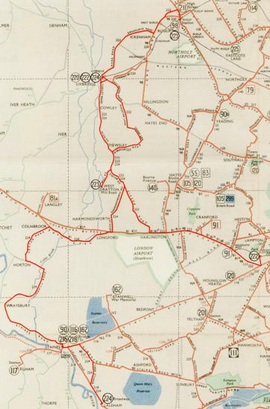
This version of
the 224 is shown on the 1949 bus map (© London
Transport), also showing the 222 and 223, and the 162 which
replaced the 224 Stanwell section the previous year.
|
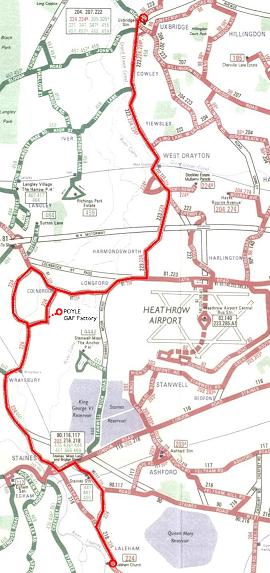
Here, the 1972 map shows the
alternative routes serving Horton and Poyle; the later run to Poyle
GAF Factory is indicated. Map © London
Transport
|
Terminal working at LALEHAM: from Laleham Road into
Ashford Road, set down at The Turk's Head, continue along Ashford
Road to turn via the forecourt of The Feathers and return to pick
up at The Turk's Head.
Terminal working at COLNBROOK: from Bath Road, Rodney Way,
Coleridge Crescent to stand, return direct to Bath Road.
Frequency
| Year |
Mon-Fri |
Sat |
Sun |
| 1936 |
60 mins |
60 mins ‡ |
40 mins † |
| 1938 |
60 mins ‡ |
60 mins ‡ |
40 mins † |
| 1941 |
60 mins |
60 mins ~‡ |
40 mins † |
| 1946 |
20 mins ~‡ |
20-30 mins ~‡ |
40 mins † |
| 1951 |
60 mins ~◊ |
30 mins ~ |
40 mins ~ |
| 1953 |
60 mins ~◊ |
30 mins ~ |
40 mins ~ |
| 1959 |
60 mins ~◊ |
30 mins ~ |
40 mins ~ |
| 1964 |
60 mins ~◊ |
60 mins ~◊ |
60 mins ~ |
| 1969 |
60 mins ~◊ |
60 mins ~◊ |
60 mins ~ |
| 1971 |
60 mins |
60 mins * |
- |
| 1976 |
60 mins |
60 mins * |
- |
* more frequent Uxbridge - West Drayton
~ more frequent Uxbridge-Harmondsworth
‡ more frequent Staines-Stanwell
† Staines-Stanwell only
◊ more frequent Staines - Laleham
The route took about 66 minutes from Uxbridge to Laleham.
About 30 minutes of this was taken up by the less frequent section
between Harmondsworth and Staines.
Faretable
A faretable for the final version of the route is here.
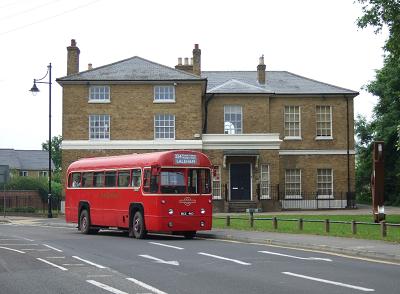 RF allocation RF allocation
PVR 1958 (Nov): Mon-Fri 6 TD, Sat 2 RF + 5 TD, Sun 3
RF + 3 TD
PVR 1959 (May): Mon-Fri 6 TD, Sat 2 + 5 TD, Sun 6
TD
PVR 1959 (Jun): Mon-Fri 6, Sat 7, Sun 6
PVR 1959 (Nov): Mon-Fri 4, Sat 5, Sun 4 (northern
section covered by 222)
PVR 1960 (Sep): Mon-Fri 6, Sat 7, Sun 6
PVR 1961 (Mar): Mon-Fri 6, Sat 7, Sun 7
PVR 1971 (Jan): Mon-Fri 5, Sat 5, Sun -
PVR 1976 (May): Mon-Fri 3, Sat 4, Sun -
Re-creation
RF486 worked the 224 between Laleham and Uxbridge at the
Uxbridge Running Day in 2006.
RF486, heading for Laleham
at the end of the day, pauses by the old Staines West Station
terminus. The famous forecourt has now been grassed over.
Photo © Peter
Osborn
|
|